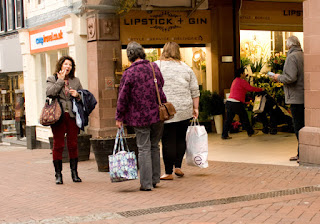Language
I appreciate that academics write for academics and therefore are obliged to use academic language. But I'm not obliged to like it. I came across Barthes in a course book:
Photography: A Critical Introduction, (Fourth Edition, edited by Liz Wells, Routledge, Abingdon, 2009), which gave me the impression that he was an even more difficult read than
it was. When I found
Camera Lucida (Roland Barthes, translated by Richard Howard, Vintage, London, 2000) I had to take a look. I found the first chapter quite accessible, so I bought the book.
There's a question with translation: do you translate word for word, phrase for phrase, or do you re-write it in English? The translator has adopted the former, and I found occasional difficulties where the literal translation reveals a difference between English and French usage:
en effet is not exactly the same as
in effect; I think
unseen vision conveys more than
blind field. I wished my French were good enough to be able to read Barthes' original. I got used to it, and found that what I'd seen as difficulties were the French coming through: they conveyed the sound and feel of the original language, which added to my pleasure.
Barthes writes in a chatty, rambling style, continually interrupting himself in parentheses and using Latin, Greek and German words where French ones don't convey what he wants to say. He is primarily concerned with photographs of people. He's not an easy read, but it's a short book, with short chapters. I've summarised what I think he says.
Photography and Death
A photograph is always identified by its subject, whereas a painting is always firstly a painting; its subject comes second. A photograph is always of something that existed. In this it differs from a painting, for which the subject need not have existed, except in the mind of the painter. Photographs are redolent of death: a photograph persists after its subject has gone, so even images of people now living foreshadow their death. 'All those young photographers who are at work in the world, determined on the capture of actuality, do not know that they are agents of Death.' (op cit, p.92)
'Whoever looks you straight in the eye is mad'
(op cit, p.113). People always
pose in photographs. The result is a conflict between 'the one I think I am, the one I want others to think I am, the one the photographer thinks I am, and the one he makes use of to exhibit his art.' (op cit, p13).
The "Je Ne Sais Quoi"
He wonders why he responds to some photographs and not others, and decides that most photographs are
unary; they're only about one thing: the subject, what it's about, which he terms the
studium. He finds these inert. The ones that interest him have something else to prick him, to touch him. He calls this the
punctum. 'If I like a photograph, if it disturbs me, I linger over it.' (op cit p.99). Something
happens in interesting photographs. He illustrates this with a photograph
: Nicaragua, 1979, by Koen Wessing:
http://www.arts.ucsb.edu/faculty/budgett/classes/art19/camlucid_files/image002.gif
where armed soldiers patrol the streets while behind them two nuns cross the road. This 'co-presence of two discontinuous elements, heterogenous in that they do not belong to the same world' (op cit, p23); the intrusion of normal, peaceful life into a war zone, is the
punctum to warfare's
studium.
Attempts to insert a
punctum by creating a surprise don't impress him. The
punctum can't appear intentional, contrived. It may be latent, not appearing straight away. It causes the image to live outside, beyond the occasion of viewing.
Landscape: he needs to connect with it, not simply observe: 'photographs of landscape (urban or country) must be
habitable, not visitable.' (op cit, p.38)
'What I can name cannot really prick me.' (op cit, p51). If there's an English term meaning
punctum, it must be
je ne sais quoi.
Bartes' Response to Photographs
He examines his response to a photograph of his mother, taken before his birth, when she was a child. He finds it difficult to recognise a loved one from a photograph because he knows a lot more than the photograph conveys, but, 'I studied the little girl and at last rediscovered my mother.' (op cit, p.69)
The photograph is tragically limited: it can only show what was seen; not the subject's entirety; not the whole truth. Yet some photographs express a non-photographic truth; they note not only a characteristic, they are
like the subject. They occasionally reveal something about the subject that is not normally perceived.
Seeing a hand-tinted photograph made him feel that
however it's created, 'color is a coating applied
later on to the original truth of the black-and-white photograph.' (op cit, p.81)
In disagreement with semiologists and sociologists, he's a realist, believing that a photograph is an image without 'code', though accepts that 'certain codes do inflect our reading of it.' (op cit, p.88).
'The Photograph is violent: not because it shows violent things, but because on each occasion it
fills the sight by force, and because in it nothing can be refused or transformed' (op cit, p.90)
Mad or Tame?
'Society is concerned to tame the Photograph, to temper the madness which keeps threatening to explode in the face of whoever looks at it. To do this, it possesses two means.
'The first consists of making Photography into an art, for no art is mad.
'...The other means of taming the Photograph is to generalize, gregarize, banalize it until it is no longer confronted by any image in relation to which it can mark itself, assert its special character, its scandal, its madness.' (op cit, pp.117-118).
Other opinions exist, e.g.
http://csmt.uchicago.edu/annotations/barthescamera.htm
I want to take photographs with a
punctum, a
'je ne sais quoi' that makes people linger over them. A landscape may be amazing or beautiful, but without a
punctum it does not engage me.






























